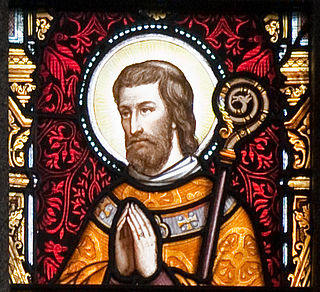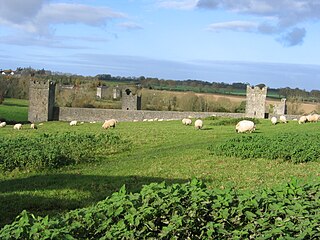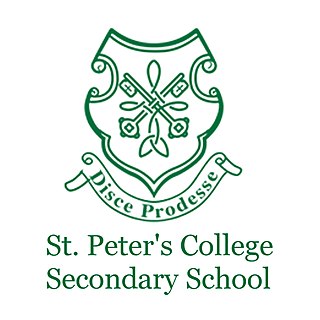Related Research Articles

County Wexford is a county in Ireland. It is in the province of Leinster and is part of the Southern Region. Named after the town of Wexford, it was based on the historic Gaelic territory of Hy Kinsella, whose capital was Ferns. Wexford County Council is the local authority for the county. The population of the county was 163,527 at the 2022 census.

Viscount Mountgarret is a title in the Peerage of Ireland.

Dunbrody Abbey is a former Cistercian monastery in County Wexford, Ireland. The cross-shaped church was built in the 13th century, and the tower was added in the 15th century. With a length of 59m the church was one of the longest in Ireland. The visitor centre is run by the current Marquess of Donegall and has one of only two full sized hedge mazes in Ireland.
Diarmait Mac Murchada, was King of Leinster in Ireland from 1127 to 1171. In 1167, he was deposed by the High King of Ireland, Ruaidrí Ua Conchobair. To recover his kingdom, Mac Murchada solicited help from King Henry II of England. His issue unresolved, he gained the military support of the Richard de Clare, 2nd Earl of Pembroke, thus initiating the Anglo-Norman invasion of Ireland.

Saint Máedóc of Ferns, also known as Saint Aidan, Saint Madoc or Saint Mogue, was an Irish saint who was the first Bishop of Ferns in County Wexford and the founder of thirty churches. His birth name was Áed, the name of the Irish god of the underworld, meaning "fire". The name Aidan is a diminutive form of Aed or Aodh, and was also a form of the Latin name Dominus. Máedóc and Mogue are other pet forms of Aed or Aodh, formed from the Irish affectionate prefix mo- and the diminutive suffix -óg, meaning "young", making for something like "my dear little Aodh".

Kells Priory is one of the largest medieval monuments in Ireland. The Augustine priory is situated alongside King's River beside the village of Kells in the townland of Rathduff (Madden), about 15 km south of the medieval city of Kilkenny. The priory is a National Monument and is in the guardianship of the Office of Public Works. One of its most notable features is a collection of medieval tower houses spaced at intervals along and within walls which enclose a site of just over 3 acres (12,000 m2). These give the priory the appearance more of a fortress than of a place of worship and from them comes its local name of "Seven Castles".

St Peter's College, Wexford is an Irish secondary school and former seminary located in Summerhill, overlooking Wexford town. It is a single-sex school for male pupils. Currently, the school has 785 students enrolled.
Richard Butler, 1st Viscount Mountgarret was the son of Piers Butler, 8th Earl of Ormond and Lady Margaret Fitzgerald. He married his half first cousin Eleanor Butler, daughter of Theobald Butler of Polestown, the illegitimate brother of the 8th Earl of Ormond. He was created 1st Viscount Mountgarret in 1550.

The Bishop of Ferns is an episcopal title which takes its name after the village of Ferns in County Wexford, Ireland. In the Roman Catholic Church it remains a separate title, but in the Church of Ireland it has been united with other bishoprics.
The Bishop of Ferns and Leighlin was the Ordinary of Church of Ireland diocese of Ferns and Leighlin in the Province of Dublin. The diocese comprised all of counties Wexford and Carlow and part of counties Wicklow and Laois in Ireland.
Events from the 6th century in Ireland.

Joseph Deane Bourke, 3rd Earl of Mayo was an Irish peer and cleric who held several high offices in the Church of Ireland including Bishop of Ferns and Leighlin (1772–82) and Archbishop of Tuam (1782–94).

Drumlane is a townland situated near the village of Milltown, area 85.76 hectares, in County Cavan, Ireland. Drumlane is also the name of the civil parish in which the townland is situated. Saint Columba brought Christianity to Drumlane in 555, and Saint Máedóc of Ferns was the founder of an early Drumlane monastery. Saint Máedóc made the Connachta nobleman Faircheallaigh the first Abbot of Drumlane at the end of the sixth century and his Ó Faircheallaigh descendants became historically the Erenagh Abbots of Drumlane. The name Drumlane denotes the drumlin region of low hilly ribbed moraines formed over a limestone bedrock created by the movement of glacial ice and melt water during the last ice age. Several townlands in the neighbourhood are prefixed with the word 'Drum' ('Droim'), while several others are prefixed with the word 'Derry' ('Doire'), which is Irish for oak.
Robert Sutton was an Irish judge and Crown official. During a career which lasted almost 60 years he served the English Crown in a variety of offices, notably as Deputy to the Lord Chancellor of Ireland, Chief Baron of the Irish Exchequer, Master of the Rolls in Ireland, and Deputy Treasurer of Ireland. A warrant dated 1423 praised him for his "long and laudable" service to the Crown.

Sir John Hotham, 9th Baronet, DD (1734–1795) was an English baronet and Anglican clergyman. He served in the Church of Ireland as the Bishop of Ossory from 1779 to 1782 and Bishop of Clogher from 1782 to 1795.

Selskar Abbey is a ruined Augustinian abbey in Wexford, Ireland. Founded in the twelfth century, the abbey's full name was the Priory of St Peter and St Paul.

Clonmines is a civil parish and townland in the Bannow Bay area of County Wexford, Ireland, the site of "the finest example in Ireland of a deserted medieval borough". It is situated in the barony of Shelburne, southwest of Wellingtonbridge on the northwest shore of Bannow Bay. The parish of Clonmines contains the townland of the same name and the smaller townland of Arklow, with respective areas of 1,258 acres (509 ha) and 127 acres (51 ha).
Saint Nissen was an early Christian convert who was abbot of a monastery in County Wexford, Ireland.

Mountgarret is a townland in New Ross, County Wexford, Ireland. It is known for the ruins of a medieval tower house that was built by the Bishop of Ferns in 1408.
References
- 1 2 3 Patrick Barrett Ricorso.
- ↑ Cotton 1848, p. 333.
- 1 2 3 Ball, F.Elrington The Judges in Ireland 1221-1921 London John Murray 1926 p. 178
- ↑ Dempsey 2015.
- ↑ Patent Roll 11 Henry IV
- ↑ Cotton 1848, p. 334.